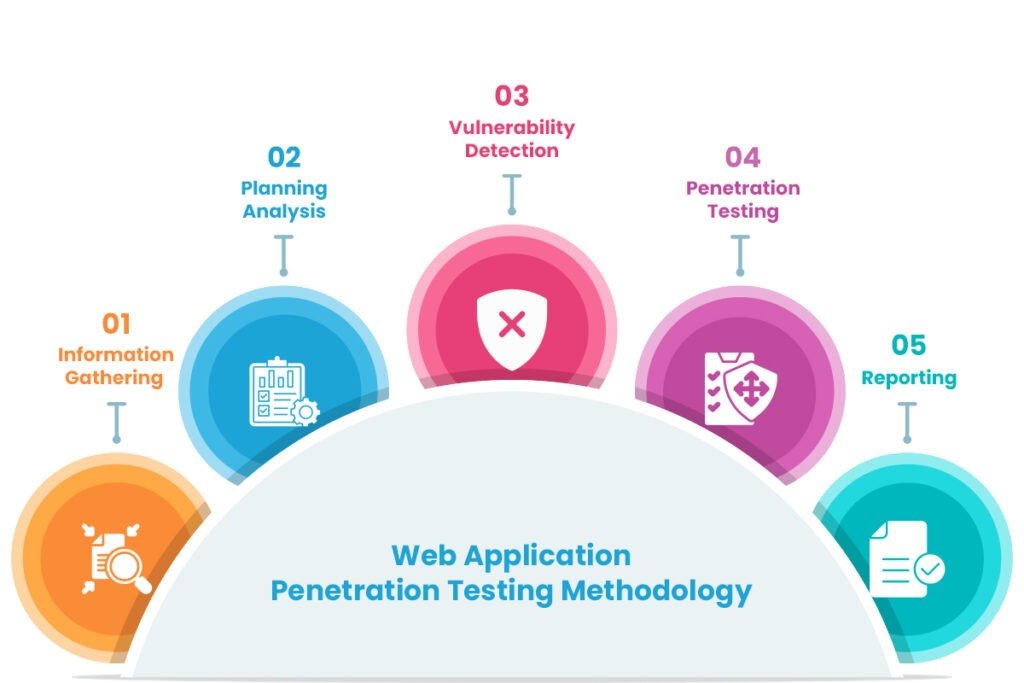Testing Service for Web Application Penetration?
Web application penetration testing is a crucial component of the process of mimicking system attacks to obtain sensitive data.
The staff at Penetration Testing Services will mimic an actual attack on your devices, networks, apps, and/or users to show you how secure your important systems and infrastructure are as well as what needs to be done to make them more secure.
Open Source Security Testing Methodology Manual and the Penetration Testing Execution Standard Rapid7’s application penetration testing service leverages the Open Web Application Security Project (OWASP), a comprehensive framework for assessing.
Web Application Penetration Testing Requirement
Web application Penetration testing is important because web applications are secure and free of flaws, which protects users from cyber Attacks like data theft and sensitive information exposure
Web application penetration testing is a proactive way to identify vulnerabilities in web applications that could lead to unauthorized access and data exposure.
It involves simulating attacks on a system in an attempt to gain access to sensitive data, providing information about the target system, identifying vulnerabilities within it, and uncovering exploits that could compromise the system.
Different companies offer web application penetration testing services including Securium Solutions and Cyber Legion.
These services employ manual and automated penetration testing processes using commercial, open-source, and proprietary security testing tools to evaluate web applications from the perspective of anonymous and authenticated users.
The level of testing can be tuned based on the risk profile of each tested application.

Methodologies and Approaches of Web Application Penetration?
On web application penetration testing service (which includes mobile applications and APIs), one of the most common inquiries we receive is on the approach we employ.
Naturally, consumers are curious about how we plan to test their assets, and, unexpectedly, it might be challenging to obtain this information from your pen testers.
Or occasionally, they’ll merely mention that they utilize a large standard while pointing you in that direction. However, we believe you must comprehend the steps and general structure of a typical exam for us.
Common Vulnerabilities Web Application
Information provided by Securium Solutions security system vulnerabilities are holes and shortcomings that let unauthorized parties access and change certain parts of the system, opening the door for malevolent action.
Attack Vectors of Web Application
Attack vectors are the techniques used by enemies to get access to or penetrate your network. Attack vectors come in a variety of shapes and sizes, including ransomware and malware, phishing, compromised credentials, and man-in-the-middle assaults. Certain attack vectors focus on gaps in your infrastructure and security, while others aim to exploit vulnerabilities in the people who have access to your network.
Common Vulnerabilities and Attack Vectors of Web Application Penetration Testing Service
In the exciting field of cybersecurity, web applications are the main target of attackers who want to exploit security vulnerabilities and compromise personal data. To strengthen their defense systems, organizations rely on the use of test networks. This is important for identifying and managing threats. Let’s take a look at the most common vulnerabilities and attacks discovered during this basic security assessment.
- Injection attacks – Common threats include injection attacks such as SQL injection (SQLi) and cross-site scripting (XSS). Attackers inject malicious code into login fields and exploit vulnerabilities in database queries or customer records to access, use, or steal personal data. Authentication and auditing courses: Weak authentication methods, such as commonly used or easily suspected credentials, open the door to unauthorized access. Course management errors, such as Price manipulation, and other techniques such as price theft allow an attacker to impersonate a user and control an unauthorized account.
- Weak Controls – Inadequate controls can allow attackers to bypass the authorization process and gain unauthorized access. The combination of poor availability and resources and insufficient authentication makes the system unusable.
- Disclosure of sensitive information – Failure to conceal sensitive information, misuse of login information, or inadequate protection of sensitive information makes the system vulnerable to data leaks. Attackers use these vulnerabilities to steal sensitive information and compromise user privacy and compliance requirements.
- Poor security design – Incorrect security settings, outdated software, or poor error management create entry points for attackers. An exposed management interface, directory, or endpoint provides attackers with valuable information to exploit vulnerabilities and gain unauthorized access.
- Site Request Forgery (CSRF) – A CSRF attack uses an authenticated user to perform unauthorized actions on the Internet. By tricking the user into making malicious requests, the attacker can abuse the trust between the user and the website, causing unwanted actions and exploits. Weak encryption: Weak algorithms, poor key management, or inadequate protection of crypto assets reduce data security measures. Attackers can use these vulnerabilities to hide sensitive information, bypass authentication, or forge digital signatures.
- Components with known vulnerabilities – Other libraries, components, or frameworks may contain known vulnerabilities. Without patches and updates, its system is vulnerable to exploitation by attackers who use publicly disclosed vulnerabilities to compromise web applications.
Website tests play an important role in identifying these vulnerabilities and reducing their risks. By simulating real-world attack scenarios, companies can better understand their security and take proactive measures against emerging threats.
In summary, understanding common vulnerabilities and attacks targeted by intrusion detection software is crucial to improving Internet security. By effectively addressing these challenges, organizations can strengthen their defenses, protect sensitive data, and maintain trust in an increasingly competitive world.
What is the Web Penetration Testing Methodology?
There is a difference between mobile applications and web applications. Penetration testing focuses on the environment surrounding a web application by gathering information about the application using public web pages. The end user will use the collected information to map the web hosting network before investigating possible injection attacks.




